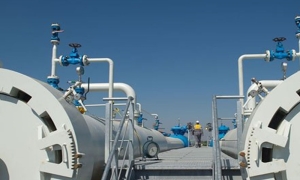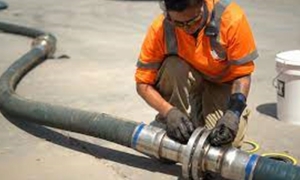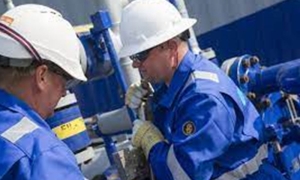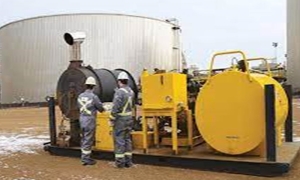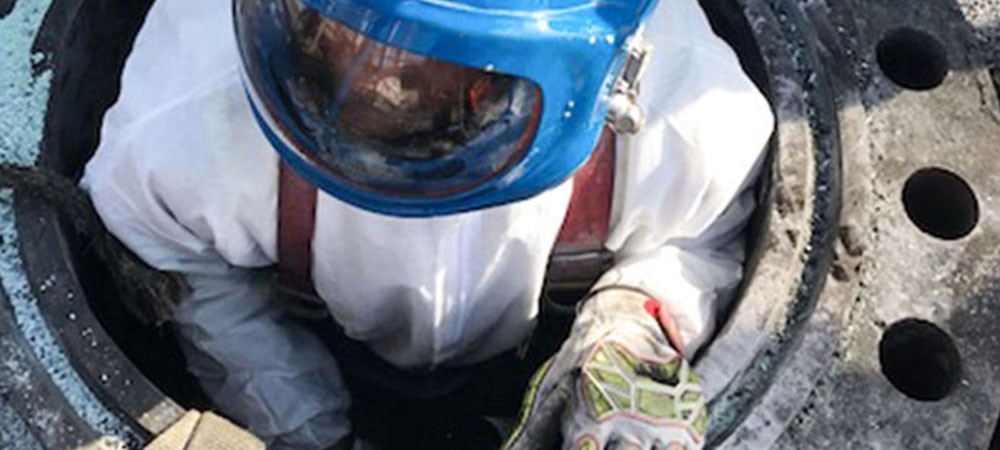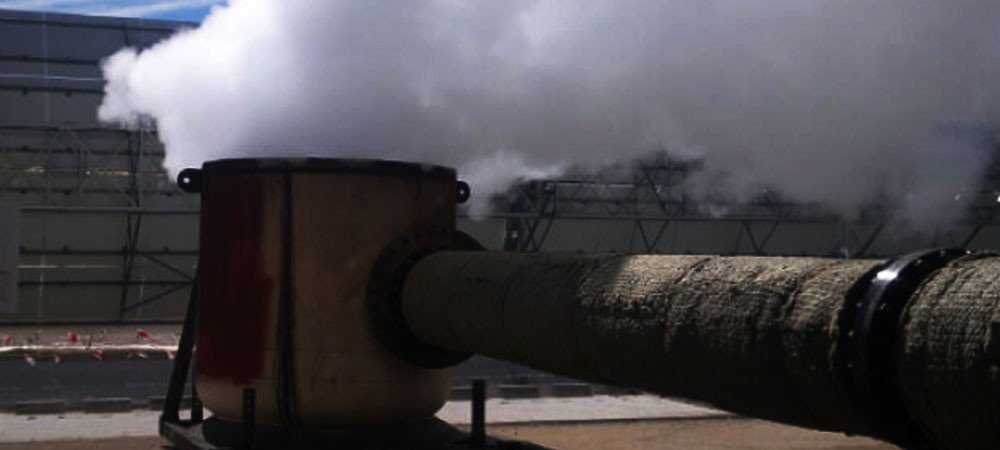Hydrotesting
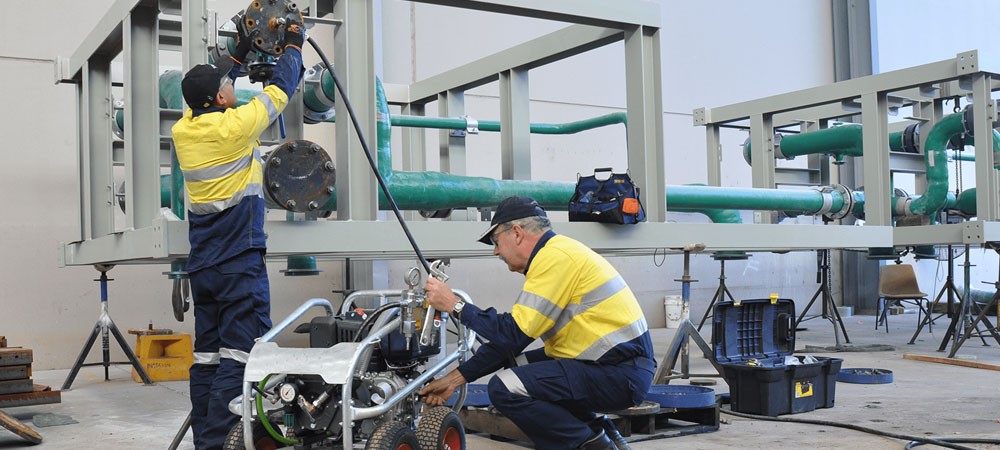
Hydrotesting
This part of the pre-commissioning procedure tests the strength of the pipelines and whether they would leak when a substance is pushed through them. It is done to ensure for the second time that there are no defects in the pipeline. It serves as the final step in testing the structural integrity of the pipeline.
Hydrotesting is done by adding water, typically dyed in a prominent color, to the pipeline and removing air. Then the pipeline is pressurized up to a specific limit for some time. The pressure is then held for some time to detect any leakages in the pipeline, or any structural detects forming. Cracks in the pipeline can be visually detected, especially if the water had been dyed.
HYDROTESTING SERVICES
Hydrostatic testing is a procedure designed to test for strength and leaks in piping systems, boilers, gas cylinders, and pressure vessels to confirm they operate properly, even under extreme conditions. Tests are typically required after repairs and shutdowns to validate equipment can successfully return to operation. Testing is conducted at higher pressures than normal operating pressures, typically up to 150 percent of the designed pressure.
Why pick us for Hydrostatic Testing?
The hydrostatic testing process requires high caution and precision, which only people with decades of experience can execute, fortunately, experience in this field.
There are certain unsaid norms followed by such experts when it comes to high-pressure testing services. For instance, you can quickly identify the location of the leak if the water has a colorant added to it.
Usually, the strength of the container is tested by measuring its permanent deformation. Hydrostatic testing is a standard method used to test pressure vessels and pipes. Testing every vessel is very important; if ignored, there are chances the container might explode when subjected to high pressure while transporting.
Be it a pipeline, fuel tank, or any container - EMBARK provides one of the best high-pressure testing services in Saudi Arabia.
Initially, a vessel undergoes the Hydrostatic testing process. Then, at regular intervals, these vessels are subjected to the proof pressure test, also known as the modified hydrostatic test. Our team of experts follows stringent regulations while checking any product, alongside making sure that this testing process maintains durability and safety standards over time.
Walking through the process, here is an overview of what exactly happens during the testing procedure.
The container is filled with an incompressible liquid (water or oil.) Next, the fluid is pressurized to test the pressure, and the container is examined for permanent changes in shape or leakages. Dyes (red or fluorescent) may also be added to the liquid - this helps to identify the leaks easily. The pressure during the test is comparatively higher than that of the standard operating pressure; this is done to ensure safety.
HYDROTESTING SERVICES
Hydrostatic testing (also known as hydro testing or pressure testing) is the process of checking piping systems, gas cylinders, builders, and pressure vessels for strength and leakage. Hydrostatic testing is often seen after shutdowns or repairs as equipment must be checked and validated before going into service operation again. Testing must be done when the equipment is shut down to monitor for any abnormal conditions or signs of leaking:
'Although hydrostatic testing is considered to be a non-destructive testing method, the equipment can rupture and fail if the inspection exceeds a specified test pressure or if a small crack propagates rapidly.'
How Does Hydro Testing Work?
Hydrostatic testing service involves a professional filling up the component (components such as pipes or gas cylinders) with water, removing all the air from within, and finally, adding pressure to the system up to 1.5 times the design pressure limit of the unit.
Some companies may even apply tracers or fluorescent dyes to the liquid used to find the exact location of any existing leaks. The tested component is then monitored for any pressure change(s), if any, and full tests are run in it before the equipment can return to normal operations again.
Most companies will have a hydro testing procedure that takes care of resources like hydro testing fluids and equipment rentals. Different cases will require different methods and solutions when it comes to hydro testing.
Types Of Hydro Testing Methods
Two primary techniques used to test small pressure vessels and gas cylinders include:
- The Water Jacket Method
A vessel is filled with water and is then loaded into a sealed chamber called a test jacket, also filled with water. The vessel is then pressurized inside the test jacket for a certain amount of time.
Once the vessel expands, water gets forced out into a glass tube used to measure the total expansion. The vessel is then depressurized and will shrink to its original size (results may vary). The final condition of the vessel is used to determine its reusability or whether it needs to be replaced instead.
- The Direct Expansion Method
A vessel or gas cylinder is filled with a specified amount of water. The system is pressurized so the amount of water that is expelled can be recorded once the pressure is released.
The amount of water forced into the vessel, the test pressure, and the amount of water expelled from the vessel are all recorded and used to determine the confirmed working status of the component.
HYDROTESTING SERVICES
Hydrostatic (Hydro) Testing is a process where components such as piping systems, gas cylinders, boilers, and pressure vessels are tested for strength and leaks. Hydrostatic tests are often required after shutdowns and repairs to validate that equipment will operate under desired conditions once returned to service.
Furthermore, hydrostatic testing cannot be performed during normal operations and cannot monitor equipment for leaks after the test has been performed. On-stream equipment integrity is best managed by an effective fixed equipment mechanical integrity program.
Although hydrostatic testing is considered to be a non-destructive testing method, the equipment can rupture and fail if the inspection exceeds a specified test pressure or if a small crack propagates rapidly.
HOW DOES HYDROSTATIC TESTING WORK?
Hydrostatic testing is a type of pressure test that works by completely filling the component with water, removing the air contained within the unit, and pressurizing the system up to 1.5 times the design pressure limits of the unit. The pressure is then held for a specific amount of time to visually inspect the system for leaks. Visual inspection can be enhanced by applying either tracer or fluorescent dyes to the liquid to determine where cracks and leaks are originating.
COMMON HYDROSTATIC TESTING METHOD
There are three common hydrostatic testing techniques that are used to test small pressure vessels and cylinders: the water jacket method, the direct expansion method, and the proof pressure testing method.
Water Jacket Method
To conduct this method, the vessel is filled with water and loaded into a sealed chamber (called the test jacket) which is also filled with water. The vessel is then pressurized inside the test jacket for a specified amount of time. This causes the vessel to expand within the test jacket, which results in water being forced out into a glass tube that measures the total expansion. Once the total expansion is recorded, the vessel is depressurized and shrinks to its approximate original size. As the vessel deflates, water flows back into the test jacket.
Sometimes, the vessel does not return to its original size. This second size value is called permanent expansion. The difference between total expansion and permanent expansion determines whether the vessel is fit for service. Typically, the higher the percent expansion, the more likely the vessel will be decommissioned.
Direct Expansion Method
The direct expansion method involves filling a vessel or cylinder with a specified amount of water, pressurizing the system, and measuring the amount of water that is expelled once the pressure is released. The permanent expansion and the total expansion values are determined by recording the amount of water forced into the vessel, the test pressure, and the amount of water expelled from the vessel.
Proof Pressure Method
The proof pressure test applies internal pressure and determines if the vessel contains any leaks or other weaknesses such as wall thinning that may result in failure. In the United States, this method is only permitted when the U.S. Code of Federal Regulations does not require permanent and total expansion values to be recorded.
Alternative Methods
Some equipment may not be designed to handle the loads required for a pressure test. In these cases, alternative methods such as pneumatic testing should be employed. Pneumatic testing is another type of pressure test that involves pressurizing the vessel with a gas such as air or nitrogen instead of water. However, special caution should be used when performing pneumatic testing as gaseous mediums can be compressed and contained in larger amounts compared to hydrostatic testing.
HYDROTESTING SERVICES
Hydrotest, also known as the Hydrostatic test, is a vital procedure in both construction and maintenance of the piping system. Before the new piping system runs into operation, it is necessary to make sure that, they are correctly commissioned, and ready to use.
Also, proper maintenance of the piping system requires some intervals (shutdowns). So, if any piping system is susceptible to failure or leakage, it can be caught during preventive maintenance.
The processing industries may have many vessels and piping network, that undergoes high pressure. So, it is required to perform a hydro test to ensure ensures that the weld and flange joints are fitted properly by the fitters. It also ensures that the used material can sustain the pressure and that the flowing fluid does not leak out of the piping system.
Why Perform Hydrotest?
We must know the reasons behind the hydro test performance. Let us see some of the important points below-
Newly constructed piping systems are typically pressure tested. Older lines, that are already in service may be re-tested to ensure the piping system is still safe and reliable. Sometimes it is required to know if the same line is acceptable for the higher operating pressure or not for any modification in the system.
- To ensure the integrity of the piping system.
- To ensure the safety, reliability, and leak tightness of the pressurized piping system.
- To check out the strength of weld joints and the materials used to carry out the process.
- To inspect the flange joints.
- To ensure smooth performance during the operational cycle
- To relieve the stresses from the system.
Types of Pressure Tests
There are mainly two types of pressure tests carried out in the industry-
- Hydro-static Test (Hydrotest)
- Pneumatic Test
Hydrotest
The hydro test is performed by using water as the test medium.
Pneumatic Test
The pneumatic test is performed by using air, nitrogen, or any non-flammable gases.
